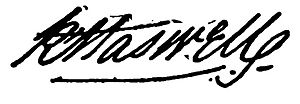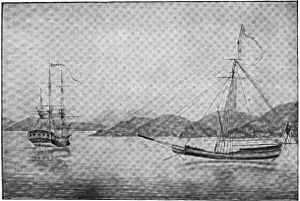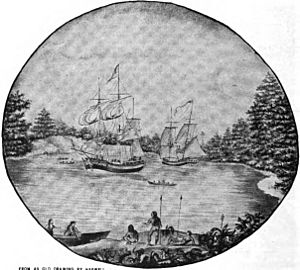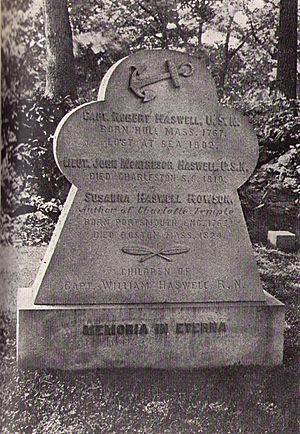Robert Haswell facts for kids
Quick facts for kids
Robert Haswell
|
|
|---|---|
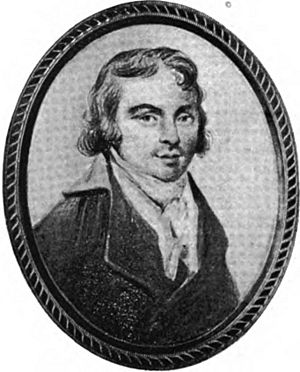 |
|
| Born | November 24, 1768 |
| Died | 1801? at sea
|
| Occupation | merchant sea-captain, naval officer |
| Spouse(s) | Mary Cordis |
Robert Haswell (born November 24, 1768 – disappeared 1801?) was an early American sea captain. He was known for trading furs in the Pacific Northwest of North America.
His detailed journals from these trips are very important. They are the main records of Captain Robert Gray's famous trip around the world. Later, Robert Haswell also served as an officer in the United States Navy during a conflict called the Quasi-War.
Contents
Early Life and Family History
Robert Haswell was born on November 24, 1768. He was likely born in Hull, Massachusetts. He was the oldest son of William Haswell, who was an officer in the Royal Navy. Robert's family had a long history of working in the navy. His grandfather was in charge of royal docks in Gibraltar. His uncle, also named Robert Haswell, was a Royal Navy Post Captain.
During the American Revolution, Robert's father was held under house arrest. In 1778, his family was sent back to England. They lived near Kingston upon Hull. The family struggled financially for a while. Eventually, they received money from the British government. This was to make up for the things they lost in America.
Adventures as a Sailor
Robert Haswell began his life at sea. He ended up in Boston, Massachusetts. In September 1787, he joined the ship Columbia Rediviva. This ship was from Boston and traded furs in the Pacific Northwest. He started as the third mate under Captain John Kendrick.
During the voyage, Haswell became the second mate. Later, he had a disagreement with Captain Kendrick. He then moved to a smaller ship called the Lady Washington. This ship was led by Captain Robert Gray. Even though it was a smaller ship, Haswell continued to trade for furs along the coast.
In 1789, Captain Gray and Captain Kendrick swapped ships. Haswell went with Captain Gray on the Columbia. They sailed across the Pacific Ocean, stopping at the Sandwich Isles. Then they went to Canton, China to sell their furs. They returned to Boston by sailing around the Cape of Good Hope. This journey was the first time an American ship sailed all the way around the world!
In 1790, the Columbia set out on a second voyage. Haswell was now the first mate. In March 1792, a small ship called the Adventure was built. Haswell was given command of the Adventure. This was his first time being a captain! He sailed along the coast, collecting more furs. The Adventure was sold in September, and Haswell returned to the Columbia as first mate for the trip home.
After the Columbia's second voyage, Haswell became captain of the ship Hannah. He went on a trading trip that lasted over two years. Next, he captained the John Jay to the East Indies. He married Mary Cordis in Reading, Massachusetts in 1798. They settled in Charlestown, Massachusetts and had two daughters, Mary and Rebecca.
When the Quasi-War started with France in 1799, Robert Haswell joined the United States Navy. He became a Lieutenant on the frigate Boston. His brother, John Montresor Haswell, also served on the ship.
In October 1800, they helped capture a French ship called Le Berceau. Robert's brother was badly hurt in this battle. The French officers praised Haswell for being very kind and respectful to them after they were captured.
In April 1801, Haswell left the Navy for a short time. He planned a trading trip to India. He took command of a ship called the Louisa. It was headed for the Pacific Northwest and China. The ship left Boston in August 1801 but never returned. It is not known if it ever reached its destination.
Robert's wife, Mary, later helped run a school for girls. The family placed a memorial stone for Robert, his brother, and his sister in the Forest Hills Cemetery in Boston.
Robert Haswell's Legacy
Robert Haswell is most famous for the journals he kept. These journals describe his voyages to the Pacific Northwest in great detail. They record his meetings with different native peoples and other European traders. These writings are a very valuable source of information about the history of that region.
His first journal was well-known even when he was alive. People like John Quincy Adams and David Humphreys mentioned how accurate and intelligent his journal was. Robert's brother, William Haswell, also kept a notable journal of his own voyage. The complete journals of the Columbia's voyages were finally published in 1941.


